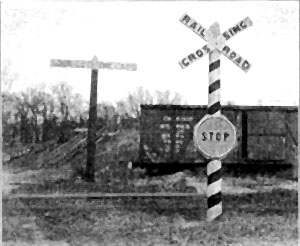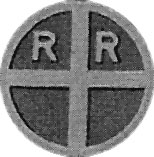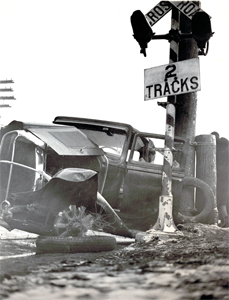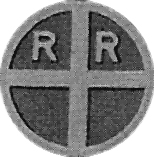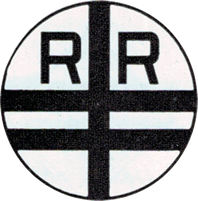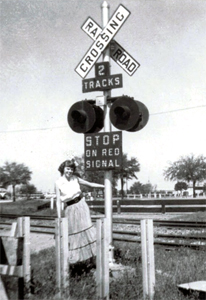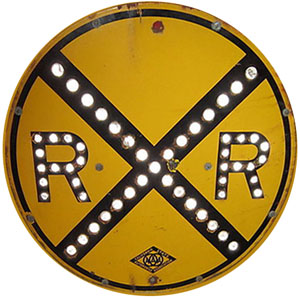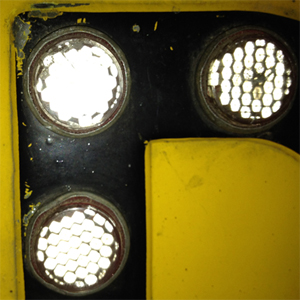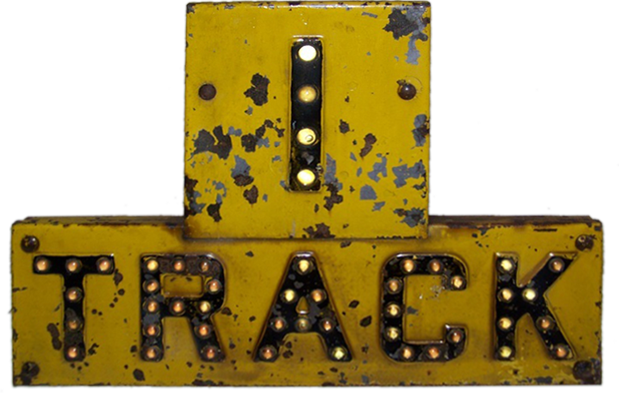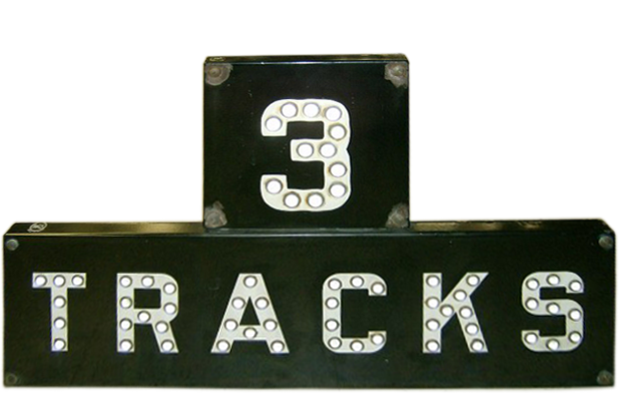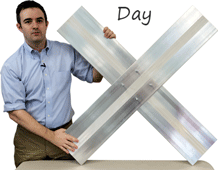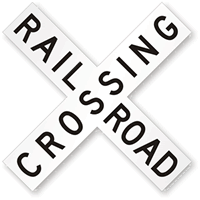
The Crossbuck sign has been called
America’s first traffic sign. At the dawn
of the automobile age, train-car collisions
were the most common and fatal of accidents
Few traffic accidents are as consistently fatal as collisions between automobiles and oncoming trains. The
New York Times reported nearly 3,000 rail crossing accidents in 2003 – a few hundred more accidents than
the Railroad Gazette recorded in 1890. The Federal Railroad Administration’s 2009 report noted that about a sixth of all 11,412 rail incidents that year took place where railways met the road. According to
Operation Lifesaver, a train-on-car collision is twenty times more likely to be fatal than a car-on-car crash.
The 20th century saw an entirely new constituency in need of regulation. As long as Americans spent most of their transit time on horseback, collisions with trains were relatively rare – it was hard not to notice an approaching train, and horses tended to jump out of the way of oncoming vehicles no matter what their riders wanted.
A 1926 crossbuck railroad crossing sign. The sign in the back shows “Look Out for the Cars”. Photo in Author’s Collection.
An early version of the crossbuck railway warning sign at Lyle Sign Post, April 1926.
An early version of the wooden railroad crossing sign. The sign here is circa 1929 and is made from cast iron.
A 1921 cast iron crossbuck sign (the back plate).
When the automobile replaced the horse, however, states became cognizant of another problem: passengers on horseback had better peripheral views of railroads than drivers in cars – and they could hear better, too. To make matters worse, in the early days of the automobile, conventions had yet to be established for everything from right-of-way to stopping at intersections and drunk driving. Drivers weren’t conditioned to stop at tracks to look both ways the way they are now, and many died in collisions with trains. Additionally, the new automobiles were noisy, making it difficult for motorists to hear approaching trains.
To prevent accidents, some railway companies paid employees to wait in small cabins and flash lanterns to warn oncoming traffic of nearby crossings. This wasn’t a very effective or affordable solution, so companies like Union Pacific began looking into alternatives as early as 1908.
An unfortunate example of what can go wrong with improper signage, circa 1936. Photo in Author’s Collection.
If signs didn’t do the trick, localities got creative like this Florida neighborhood, which installed a chicane in 1925. This is an early example of traffic calming. On the approach to a railroad crossing, the driver was forced not only to slow down but look in both directions as the chicane curves right and then left. From 1925 Lyle SignPost.
With this unforeseen epidemic of traffic accidents on the rise, automobile clubs were soon tasked with creating signs to minimize these fatal accidents. After a series of various shapes and sizes, the final product of the traffic safety initiative was the crossbuck sign, now a recognizable institution at most
railroad crossings with its large X symbol. The sign derived its unique name from a combination of two popular images. Crossbuck is a portmanteau of "cross," as in
skull-and-crossbones, and "buck," meaning wood, as in "sawbuck."
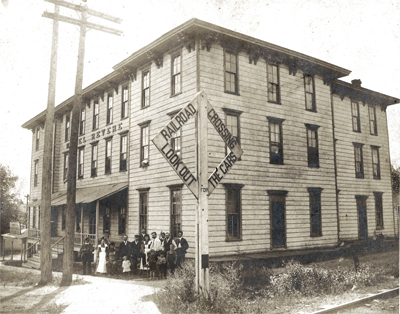
Railroad crossing signs were not always
the same “X” shape as today’s crossbucks.
This sign was posted between 1910-1920. Photo is from the Author’s Collection.
The crossbuck was initially developed as part of a larger public campaign that sought to educate drivers about the dangers of automobile travel. This was no small feat, considering that the basic principles of driver caution and etiquette were not part of the public’s consciousness at that time. The crossbuck sign was just one of a number of crucial traffic safety signs that were introduced through the campaign.
Yield, left turn lane, and
speed limit signs were also developed during this time.
However, since signs couldn’t do all the work- and drivers needed to be able to decode them- public awareness efforts accompanied the early railroad crossing sign sof the 1920s. By 1927, the state of Wyoming had set down "Ten Commandments" for safe driving, including:
- Thou shalt look both ways and listen for trains.
- Thou shalt be doubly alert if there are two or more tracks.
- Thou shalt always use good judgment at railroad crossings that thy days may be long upon the land and the enjoyment of thy car continuous.
Before the crossbuck sign became the standard type of railroad warning sign, designers tested several other potential variations on the sign’s imagery. Earlier versions featured a more intricate representation of an actual railroad intersection. After realizing that such a detailed image detracted from communicating the sign’s message, designers went back to the drawing board to come up with a simpler symbol. The new crossback sign used a large letter X with “railroad" on one branch and "crossing" on the other. With a stark black and white contrast between the lettering and the background, the committee made the wise choice to employ simplicity in forming one of the most critical safety signs in existence to this day.
When crossbuck signs were first being implemented, there was still a significant portion of the population that traveled on horseback and found railroad intersections to be nearly as dangerous as automobiles. Thus, the first crossbuck signs were placed nine feet high so that they would be visible to riders as well as drivers. Today, crossbuck signs sit much lower so that motorists can easily view them from the driver’s seat and not the saddle.
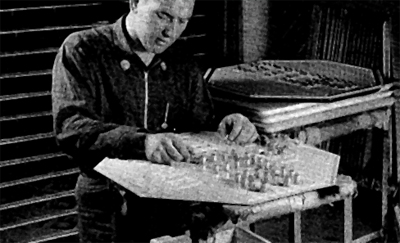
Cats eyes signs are installed on signs, circa 1925.
In the mid-1920s, sign makers began using road reflectors called Cataphote reflectors or “cats eyes” on crossbuck signs to make them more visible to drivers at night. These were used through the mid-1940s, when reflective buttons became common. Eventually, reflective sheeting gained popularity. Today, the material is still used to make street and railroad crossing signs.
During the 1930's and 1940's, Railroad Crossing signs increasingly used this simpler and more abstract design. Picking up the motif from the Crossbuck sign, a single "X" is used - regardless of the number of train tracks to cross. This railroad crossing sign has reflective Cataphotes installed.
1927 railroad crossing sign to warn motorists of two upcoming tracks.
During the 1930's and 1940's, Railroad Crossing signs increasingly used this simpler and more abstract design. Picking up the motif from the Crossbuck sign, a single "X" is used - regardless of the number of train tracks to cross. This railroad crossing sign has reflective Cataphotes installed.
The number of tracks is indicated now in the sign under the crossbuck. 1955 photo from Author’s Archives.
Now most railroad signs have reflective sheeting
on both the front and the back. This method is used to help motorists see oncoming trains at nighttime.
Over fifty percent of nighttime collisions between automobiles and trains occur when a driver thinks that the way across the tracks is clear and drives directly into a moving train. When reflective sheeting covers the back of the crossing sign as well as the signpost, the headlights from a car brilliantly illuminate the sign on the other side of the tracks. The sign shines back between the approximate six- to ten-foot gap separating each passing train car. This is sufficient to create a strobe effect, alerting the driver that a train is approaching the intersection.
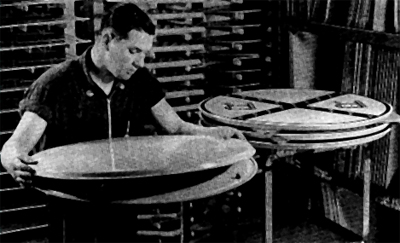
Finishing a Railroad Crossing sign
with cats eyes,circa 1925, Lyle SignPost.
The reflective sheeting on the back of crossbuck signs and posts also provides a point of reference for motorists to gauge their distance from the tracks, as well as the width of the crossing. This keeps cars out of the tracks by making drivers more aware of the crossing and its surroundings. The addition of reflectors to the front and back of crossbuck signs was a major initiative in the 1990s, and has been crucial in saving hundreds of lives ever since.
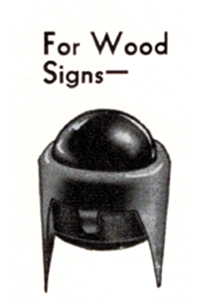
The implementation of reflective
signs was a crucial step forward in
traffic and railroad safety.
By 1935, most states had accepted
the Manual on Uniform Traffic Control Devices (MUTCD), which standardized not just railway signs but all traffic signs. Then as now, the two most common types of
railroad crossing sign were the crossbuck and a circular, RR-marked sign divided into quadrants.
Sign from the 1930s uses cats eyes.
Close-up of 1930s railroad crossing sign Cataphotes.
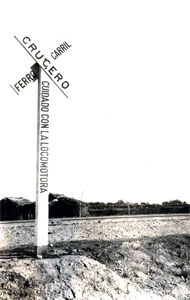
By 1942, the traditional American crossbuck sign
design was adapted by other countries although
reflective signs were less common.
Photo in Author’s collection.
Today, taking care to look both ways in sight of a crossbuck might be second nature, but the sign is still undergoing slight refinements.
Canadian crossbucks are red-bordered and have dropped words altogether, in accordance with local language laws; American laws require reflective tape for night visibility.
Over the past century, more signage has been added to major railroad crossings to enhance the effect of the crossbuck sign, including flashing red lights, warning bells, and a gate that lowers to physically prevent drivers from trying to cross the tracks. Additional laws have been implemented for longer motor vehicles such as buses that mandate drivers to stop, look, and listen for an oncoming train before crossing a set of railroad tracks.
Traffic and railroad safety endeavors have come a long way in the past century, molding a more alert and careful generation of drivers and vehicle operators. Railroad crossing signs, and especially crossbucks, are representative of the great strides the transportation industry has taken to provide a safer experience on our tracks and on our highways. Stay focused, drive slow, and keep an eye out for those bright X’s in the distance. Someone’s life might just depend on it.
1930’s Railroad Track Signs
Latest Innovation in Railroad Signs
Most railroad signs use reflective strips on the back. Over 50% of nighttime collisions between automobiles and trains result from drivers mistakenly thinking that the way across the tracks are completely clear. Driving directly into the path of a moving train is deadly. When reflective sheeting covers the back of the crossing sign as well as the signpost, headlights from a car brilliantly illuminate the sign on the other side of the tracks. Light shines back in the eight foot gaps separating each passing train car. This creates a strobe effect. After becoming law in many states, these strips have saved countless lives.












